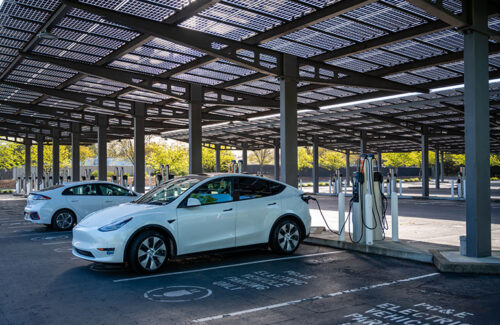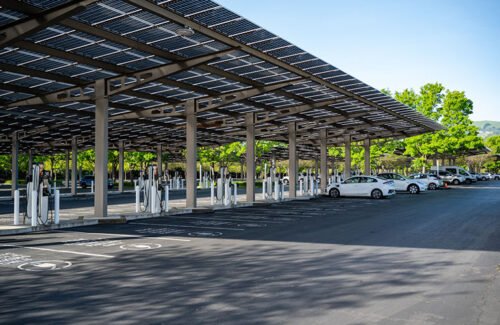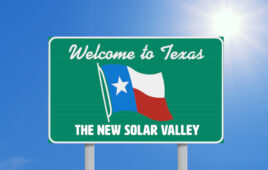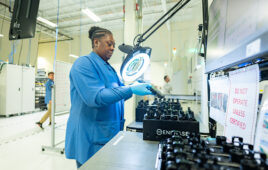
Solar energy companies are increasingly integrating electric vehicle charging into commercial and residential installations across the country. Shown above is an example of this trend at Bishop Ranch in San Ramon, California — a project developed, owned and operated by DSD Renewables. Credit: David Ganske
In the midst of America’s booming energy transition, the solar industry once again faces growing pains. Recent net-metering policy changes have created a tough market for rooftop solar, with residential installations expected to contract nearly 40% next year in California, the country’s largest residential solar market. At the same time, solar installers are struggling to stand out in an increasingly crowded industry. To stay competitive and weather the ongoing market downturn, solar companies need to diversify their businesses — and EV charging infrastructure is a perfect fit.
The seismic shifts taking place in America’s power generation are also happening in its transportation sector. Just as distributed generation is reshaping our energy systems, EVs are transforming how we drive and refuel. EVs made up nearly 9% of all U.S. vehicle sales in the first half of 2023 and are on track to surpass one million vehicles sold before the year is out. But the infrastructure to support those vehicles needs to grow, and fast: By 2030, the Biden administration aims to make 50% of all vehicle sales electric. That means 48 million EVs on the road and 1.2 million public chargers by the end of the decade, or 20-times more than exist today.
This challenge brings opportunity for commercial property owners, who are already reaping the benefits of EV charging stations in their parking lots. You can now charge your vehicle while grabbing a coffee at Starbucks, buying snacks at 7-Eleven, picking up groceries at Walmart or redecorating your home at Ikea. Charge points are available at hotel chains like Marriott and Hilton, whose EV charging infrastructure has reportedly become a major factor in converting searches to stays on its website. In L.A., the city’s request to quadruple EV chargers for a proposed skyscraper project paid off for the property developer. “If we didn’t have these 90 chargers, we would be in real trouble selling units,” he told the LA Times.
This evolution will only continue in the years to come, and solar companies that have weathered the ups and downs of the industry are well-positioned to capitalize on this new infrastructure buildout. Given the considerable overlap in technical requirements for solar and EV charging infrastructure, qualified solar technicians can easily upskill to install charging stations. Additionally, factors like shading, location and other technical considerations that can determine a solar project’s viability don’t necessarily apply for EV charging infrastructure. If there is a limitation, it’s likely due to required service upgrades from the utility. Resolving this might take additional time and coordination, but it’s hardly a deal breaker; instead, utilities are incentivized to deliver such improvements.

David Ganske
Solar installers are also uniquely suited to take on not only today’s EV charging market, but the future of charging infrastructure. In previous market downturns, solar companies have sought to diversify by incorporating energy storage into their offerings; they’re doing so again now as NEM 3.0 upends the California rooftop solar market and several other states explore similar changes to their net-metering policies. As auto manufacturers integrate vehicle-to-grid functionality into new models and bidirectional charging infrastructure comes onto the market, drivers will be able to not only charge up, but feed power back to the grid too. Solar installers’ energy storage expertise will serve them well as this technology becomes available. Meanwhile, their unique combination of renewable energy know-how will allow solar companies to upsell solar and storage technology alongside EV charging infrastructure, expanding their businesses while presenting customers with even more opportunity to lower emissions and meet their sustainability goals.
Beyond technical expertise, solar companies also have ample experience leveraging federal, state and utility incentives to help customers minimize costs and maximize benefits. The EV boom is no different: From the National Electric Vehicle Infrastructure Formula Program to incentives in states like California, New York, Michigan, Connecticut, Maryland and Utah, solar companies can assist customers in finding the most cost-effective options for EV charger installation. While installing EV charging equipment may reflect just a fraction of the cost of a residential solar project, work volume will be significantly higher and incentives can sometimes cover the entire cost, making it a complete no-brainer for customers. Even if a customer doesn’t have an EV yet, they can future-proof their home using current incentives.
Over the years, solar installers and developers have compared the constantly changing market dynamics to a game of whack-a-mole. As clean energy adoption continues to grow, net metering and other policy shifts are sure to rock the solar industry again. Meanwhile, EV infrastructure will become as ubiquitous as any other household appliance.
Embracing EV charging infrastructure as an additional line of business will help solar installers shore up their business and differentiate themselves from their competitors. Savvy solar companies are already moving in this direction — others who want to stay ahead of the pack ought to do so now, before the opportunity passes them by.





Tell Us What You Think!